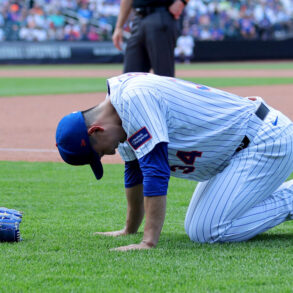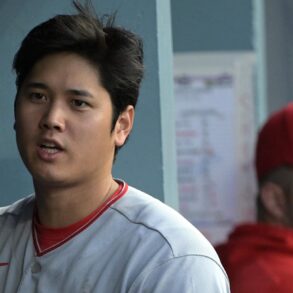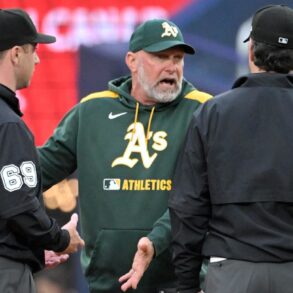
Last week, we dug into some top hitting prospects posting intriguing data over the first month of complex league play. Now, it’s time to look at a handful of pitchers impressing evaluators in the Florida Complex and Arizona Complex Leagues.
There’s plenty of fools gold in pitching performances across the complex leagues, so it’s important to look under the hood to get a deeper understanding of quality of stuff and command. While these pitchers are likely many years away from major league mounds, there’s plenty of talent that passes through the domestic complex leagues each season worth getting in on early.
Below, we will examine a dozen pitchers making waves on backfields across the country and dig into their viability as pitching prospects long term.
Ethan Dorchies, RHP, Brewers
The Brewers signed Dorchies for $162,500 in the 10th round last July out of Cary-Grove (IL) HS. After not pitching following the draft, he made his debut this spring in the Arizona Complex League. Over six appearances spanning 27 total innings, he has pitched to a 1.67 ERA with a 30.5% strikeout rate to a 7.6% walk rate.
Over those six appearances, Dorchies has three scoreless outings of four or more innings already. Mixing five pitch shapes with above-average command gives Dorchies a starting pitcher’s foundation, and its his high level of pitchability that has allowed him to succeed thus far.
Dorchies’ stuff is just average, and he features a four-seam fastball, cutter, sinker, slider and splitter. His fastball sits 89-91 mph, touching 94 mph at peak. What he lacks in velocity, however, Dorchies makes up for with unique traits. He gets 6.7 feet of extension, generating 16-17 inches of vertical break on average from a 5-foot-8 release height. This, coupled with above-average fastball command, allows Dorchies to generate whiffs at a rate of 48% overall and 33% in-zone. Added velocity in the coming years could push his heater into plus territory.
Dorchies’ primary secondary is a cutter in the mid-to-high-80s that generates whiffs at a high rate. He also blends in a sweeper slider in the low 80s and a low-80s splitter with good vertical separation off his fastball.
Dorchies has an exciting and well-rounded arsenal with remaining projection. This was a true draft find by the Brewers.
Humberto Cruz, RHP, Padres
The Padres’ No. 4 prospect is one of the most highly-touted pitching names in either domestic complex league this season. Signed out of Mexico in February 2024, Cruz made his debut in the Arizona Complex League last season, and his pro experience was limited to just a pair of one-inning appearances at the tail end of the complex season. The 18-year-old Cruz returned to the ACL in 2025 and has made five appearances, striking out nine batters with four walks in 8.2 innings.
The results have been up and down, but Cruz’s stuff is noteworthy. He mixes a four-seam fastball, slider and changeup, with the fastball seeing a vast majority of his usage. The pitch sits 94-96 mph, touches 98 at peak and features a flatter plane of approach due to his lower release height. His extension at the moment is below-average, but he’s managed to command the fastball well. It’s been less successful as a whiff-generating offering, but for that, he relies on his slider, which sits 83-85 mph, touching 87 at peak with cutter-like shape. So far this season, he has generated whiffs in-zone at a rate of 33% against it. Cruz’s changeup is nearly a non-factor at present, as he’s used it just a handful of times.
Cruz has a fastball/slider combination of above-average quality. Over the next few years, it’s simply a matter of building off of that.
Stharlin Torres, RHP, Reds
After a standout season in the Dominican Summer League in 2024, Torres made the jump to the ACL this year. Over six appearances spanning 23 innings, he has struck out 27 to just four walks. Torres has gone four innings in each of his last five outings and is in the midst of a 15-inning scoreless streak dating back to May 19.
Behind that strong performance are good metrics under the hood. Torres mixes a four-seam fastball, curveball and changeup. His fastball sits 92-94 mph with 18-19 inches of induced vertical break on average from a 5-foot-9 release height. The pitch has good plane, and he generates whiffs against it at a high rate. It has all the makings of a plus pitch.
His primary secondary is a low-80s, two-plane curveball with good depth. Torres’ ability to command the pitch is well above-average, as he’s consistently in the zone with it. His changeup shows good vertical separation off his fastball, even if it is a bit firm. He also does an excellent job killing lift and generating armside run.
Torres has the makings of a three-pitch mix of average-or-better offerings and command. The strong early performance in the ACL early is backed by quality underlying data, making Torres a name to watch.
Argenis Cayama, RHP, Giants
Cayama, the Giants’ No. 15 prospect, signed out of Venezuela in January 2024 for $147,500. He had spent time as an outfielder prior to signing but clearly picked the right path on the mound.
Over 24.2 innings in six starts this season, Cayama has pitched to a 1.09 ERA and 2.91 FIP with a 0.97 WHIP. He’s struck out 33.7% of batters faced while allowing free passes 8.2% of the time. Batters are hitting .180 against him this season, and he’s generated ground balls at a high rate.
Obviously, the performances have been noteworthy, but what’s under the hood? It starts with a three-pitch mix led by a two-seam fastball sitting 93-95 mph and touching 97. His primary secondary is a low-to-mid-80s slider with slurvy shape. His changeup has been used infrequently to begin the season, but it sits 86-88 with solid vertical separation off his fastball.
Cayama has shown excellent command of the slider to date, with an average zone rate but higher chase, whiff and strike rates. His ability to generate ground balls with his fastball/slider combo will allow him to get outs efficiently.
Esteban Mejia, RHP, Orioles
The Orioles’ No. 15 prospect has made quite the impression in his stateside debut. Over five starts, Mejia has struck out 24 batters across 19 innings, allowing just six earned runs. Command has been a bit of a bugaboo for him, however, as he’s walked 16.3% of the batters he’s faced this season.
Mejia throws two fastball shapes in a four-seamer and two-seamer, with the former seeing more usage but the latter generating better results. Mejia’s two heaters feature premium velocity, sitting 96-98 and touching 100 mph at peak. His four-seam fastball has below-average ride but good plane from a 5-foot-5 release height. His two-seamer, on the other hand, generates sink and 16-17 inches of armside run on average. He’s a short strider with below-average extension, but his lower slot allows him to generate good plane.
Mejia throws both a slider and a changeup, with the former seeing a majority of the usage. His slider sits 89-90 mph and reaches 92 mph at peak with true gyro shape and spin rates in the 2400-2500 rpm range. The pitch has generated whiffs at a rate of 48% overall, but it gets lower swing rates thanks to his command of the pitch being below-average at present. His changeup has been thrown around six percent of the time and has good velocity separation but fringy vertical separation off his fastball.
With huge stuff and the prerequisite relief risk due to a lack of precision across his arsenal, Mejia is a live arm worth watching.
Johnny King, LHP, Blue Jays
King received $1,247,500 from the Blue Jays in the third round last July but didn’t debut until this spring in the Florida Complex League. Over four appearances, he’s struck out 19 batters to three walks in 11.2 innings. King has impressed evaluators with the quality of his fastball and ability to spot it. So far, the 18-year-old has used strictly two pitches: a four-seam fastball and curveball. The fastball sits 94-95 mph, touching 96 at peak with a heavy combination of ride and armside run.
It’s likely some of these numbers come down when King debuts in Low-A and throws in front of Hawk-Eye devices in the Florida State League, but so far over his early pro sample, he is averaging between 16-18 inches of induced vertical break with 14-17 inches of armside run. There’s a possibility that our sourced data is blending a four-seam and two-seam variation, but regardless of the shape, the fastball has had immense success early, generating whiffs in-zone 43% of the time. King’s curveball is a low-80s downer with 14-16 inches of drop and around 9-10 inches of sweep. He’s still learning to command the pitch but does show some feel for spin.
Though still in the infant stages of his career, King is displaying quality traits to track.
Leomar Rosario, RHP, Astros
Signed in October 2021 out of the Dominican Republic, Rosario spent 2024 with the Astros’ Florida Complex League affiliate and returned to the level to begin 2025. Over four appearances in the FCL, he struck out nine batters in seven innings while showing big stuff and below-average command. The Astros promoted Rosario to Low-A Fayetteville May 30, and he’s made three appearances. Over eight innings, he’s struck out 11, walking five and allowing four runs.
Rosario mixes a four-seam fastball, slider and changeup. His fastball sits 96-98 mph and can reach triple digits. He generates around 16-18 inches of induced vertical break on average and roughly seven inches of armside run. Though he also generates good extension, it’s a higher release height on his fastball. His primary secondary is a high-80s gyro slider used to generate lots of swing-and-miss. His changeup is a distant third pitch and doesn’t show much fastball separation.
Rosario has loud stuff, but is likely best suited for a spot in the bullpen long term due to a lack of depth in his arsenal.
Joey Oakie, RHP, Guardians
With the cost savings netted with an underslot deal for Travis Bazzana at the No. 1 overall pick, The Guardians aggressively attacked the prep pitching market in last year’s draft. After taking Braylon Doughty in the supplemental first round, they landed Oakie in the third. While Doughty was assigned to Low-A Lynchburg, Oakie began his professional career in the Arizona Complex League.
Though Doughty has a quality arsenal, it’s command and strike-throwing that carries his profile. Oakie, on the other hand, has real fire bolts coming out of his hand. His fastball sits at 95-97 mph and he can reach back for another tick if needed. He doesn’t generate a ton of ride, but his low 5-foot-1 release height is outlier and certainly aided by 6-foot-9 feet of average extension. This creates a flatter plane of approach on Oakie’s fastball that aides in his ability to miss bats.
His primary secondary is a high-80s slider with cutter shape. He also shows a sinker variation of his fastball that has a distinctly different shape from his four-seam. His firm upper-80s changeup gets good vertical separation off the heater.
So far, the results have not yet come to fruition for Oakie, but the raw stuff is certainly there.
Grant Shepardson, RHP, Marlins
A Colorado prep arm the Marlins landed in the fifth round of last July for $897,500, Shepardson has made four starts in the FCL, striking out 14 batters to seven walks while allowing five earned runs over 13.1 innings.
Shepardson mixes four pitches: a four-seam fastball, cutter, slider and changeup. The fastball has good velocity, sitting 94-95 mph and touching 96, but he only averages about 11 inches of vertical break with moderate cut. He’ll need to add more ride or cut or move to a two-seam grip in order for this pitch to play at full-season levels.
Shepardson’s cutter, on the other hand, might be a potential plus pitch, as it comes in at 86-87 mph with spin rates in the 2700-2800 rpm range and heavy sweep. It’s a unique pitch and has generated whiffs at a rate of 43% in-zone this season. His slider, a mid-80s sweeper with between 14-15 inches of horizontal break, has also generated solid whiffs numbers early on. He’s thrown only a few changeups this season, but it’s a high-80s pitch with splitter-like shape.
Shepardson has a collection of intriguing secondaries but will need to find a better fastball shape to climb the ladder.
Luis De La Torre, LHP, Giants
An older signee out of the Dominican Republic in July 2023, De La Torre was born in Phoenix and seems to be enjoying his return to the desert. The 21-year-old spent two seasons in the Dominican Summer League before making the jump stateside. His entire arsenal is up this season with his fastball velocity making a 2+ mph jump year over year.
Such an uptick hasn’t been exclusive to the fastball, as De La Torre has seen a bump with his curveball and his slider, too. He generates 6-feet-4 of extension from a six-foot frame, lowering his release height and creating a good fastball plane. His curveball is a low-80s, two-plane breaking ball with around eight inches of drop and eight inches of sweep. His slider is a little harder in the 82-85 mph range with slurvy shape. His changeup is firm at 90 mph with little separation off the fastball.
De La Torre has made six appearances this season, pitching to a 4.22 ERA and 1.36 WHIP with 38 strikeouts to 12 walks across 21.1 innings. He’s an older prospect, but ranks 28th in the Giants’ system after following an unusual path to pro ball. He has some interesting traits and is a name worth monitoring.
Marlon Nieves, RHP, Dodgers
Signed out of the Dominican Republic in May 2023, Nieves spent two seasons in the Dominican Summer League before coming stateside. The results, however, haven’t been great so far in his domestic complex debut, as he’s pitched to a 5.18 ERA and 6.64 xFIP across 24.1 innings this season. Despite some prospect pedigree, Nieves simply has not gotten results thus far as a professional. This is due in large part to a career 17.1% walk rate across 77.1 innings. He does, however, mix some nasty stuff across his five-pitch arsenal.
Nieves sits 95-97 mph on his two-seam fastball with some sink, heavy armside run and spin rates in the 2400-2500 rpm range. He throws a four-seamer in the same velocity range, but he struggles to ride it. Nieves’ slider is his primary secondary pitch, seeing around a 20% usage rate. It’s a mid-80s sweeper averaging around 11-12 inches of horizontal break with raw spin rates in the neighborhood of 3000 rpm. He mixes in a low-90s cutter, as well, with moderate ride and cut. His changeup is thrown just five percent of the time but shows some interesting traits thanks to an ability to kill lift and generate fade that give the pitch some future projection despite its below-average vertical separation.
While the results haven’t been there, Nieves has stuff that makes you take notice.
Dalvinson Reyes, RHP, Red Sox
It hasn’t been the easiest stateside debut for the No. 30 prospect in the Red Sox system. While Reyes’ velocity is up a tick on average, his fastball command has backed up early in 2025, as evidenced by a 28.1% walk rate that has been a direct product of his fastball’s 31% zone rate. Reyes’ fastball generates a high amount of armside run, and he struggles to command the pitch to the arm side, in particular. His slider is a true gyro sitting 84-85 mph and has been a little tighter this year compared to 2024. Reyes’ changeup hasn’t been used that frequently, and it lacks vertical and velocity separation from his fastball.
A large chunk of Reyes’ runs allowed came in his first two appearances. Things have been better over his last two starts, but he did struggle with command again on Thursday. Reyes was excellent in his professional debut in 2024, throwing 17 scoreless innings in the Dominican Summer League. It’s very early in Reyes’ career, as he’s 18 for all of 2025, so it’s very likely the early struggles are just a blip.
This post was originally published on this site be sure to check out more of their content.





